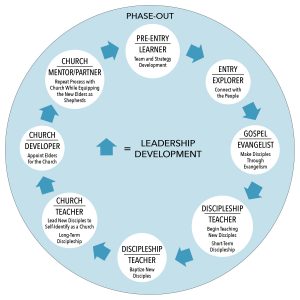

In the previous post, “Three Things to Keep in Mind When Equipping Planters for Movements,” I addressed beginning with the end in mind and planned role changes. In this post, I want you to see how we seek to involve training teams in view of the Church Multiplication Cycle. Please note: There are different variations of this cycle. Also, church planting is not as linear as the diagram below. Just as lines blur between the church planters’ roles (see previous post), lines blur between the different stages of the process. This is very important to keep in mind. For example, after disciples are made, short-term discipleship and baptism occur almost simultaneously. The diagram is simply a tool to provide a visual of the end vision.


The Church Multiplication diagram shows the overlap of the stages of church planting with the primary roles of the church planters (again, see previous post’s diagrams) and the primary actions of the church planters for each stage. Leadership (including pastoral) development happens throughout the process as the team seeks to model life and ministry (e.g., 1 Cor 11:1; 1 Thes 1:6). And everything happens with phase-out in mind.
Church planters often major on the minors. Sometimes this problem is due to a poor biblical ecclesiology for the church planting methods and strategies. Sometimes this problem is attributed to unhealthy expectations from a sending church, denomination or mission agency. Of course, there are other reasons too.
The Church Multiplication Cycle helps planters to keep things simple and to focus on the primary task of the moment. It is more important for church planters to know how to go from 0 believers to 10 new believers in a year, than it is for them to know how to form a 501(c)(3) organization, develop a web site or administrate a praise team for a reached people group. Planters frequently waste precious time developing complex church structures long before the Spirit births the church.
A familiarity with this cycle (10 parts when including Leadership Development and Phase-out) is necessary when it comes to understanding our 12-month process for equipping church planting teams. Stay tuned.

